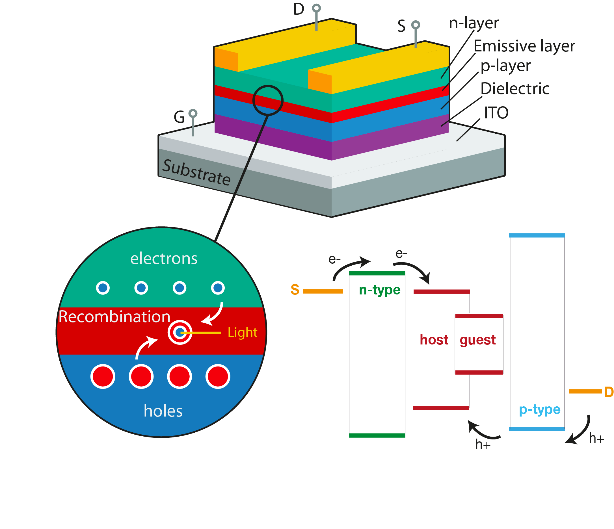Research
Organic Devices
Organic semiconductor-based devices such as organic light emitting diodes (OLEDs), solar cells, memories and organic field-effect transistors (OFETs) are expected to reduce fabrication costs and enable novel functionalities with respect to devices based on conventional materials.
Our research effort focuses on organic transistors, with a particular interest for organic light emitting transistors (OLETs) which have been increasingly gaining interest due to their two-fold functionality of behaving as thin-film transistors and being capable of generating, sensing and controlling light under appropriate bias conditions. Intrinsically very different from well-known diode counterpart (OLEDs), in terms of structures and functioning (transistor vs. diode), OLETs are easier and cheaper to fabricate, potentially less power consuming and easier to be integrated in complex architectures. Controllable by any TFT technology, OLET enables flexible application electronics.

Simplified schematics and energy diagram of trilayer structure in organic light emitting transistors, where the emissive layer is sandwiched between two semiconductor (n/p) organic layers.
OLET technology platform is rather yet largely unexplored and it offers the possibility of investigating many key aspects to deepen the general understanding of the physical properties and phenomena characterizing the structure as well as moving towards the overall improvement of the performances. This requires a cross-disciplinary effort in terms of materials study and development (i.e. organic semiconductors, dyes, dielectrics, interfaces) as well as engineering one or more components to target a specific application.
OLET can benefit from intensive research work in related fields, such as transistor technology (organic/inorganic), as well as from organic electronics and OLED field, from which materials, processes and protocols can be learnt and partially “borrowed”.
We believe that those are key features that will make OLET platform successful and will render it a compelling alternative compared to other light emission technology.
